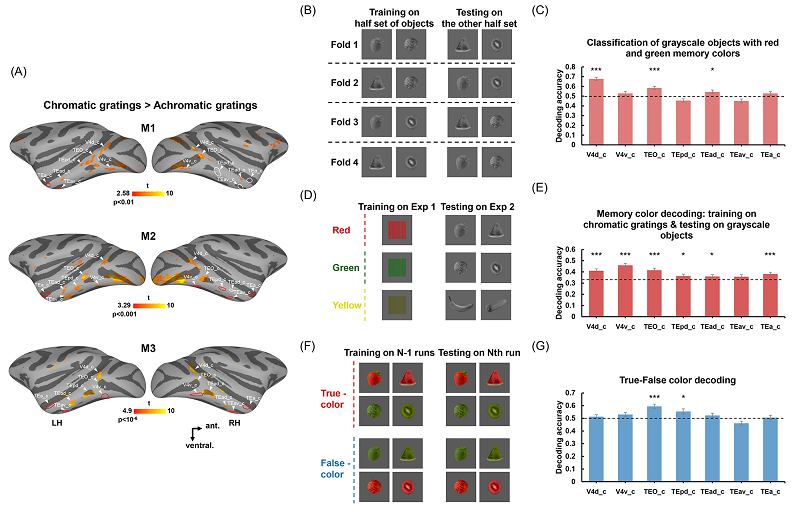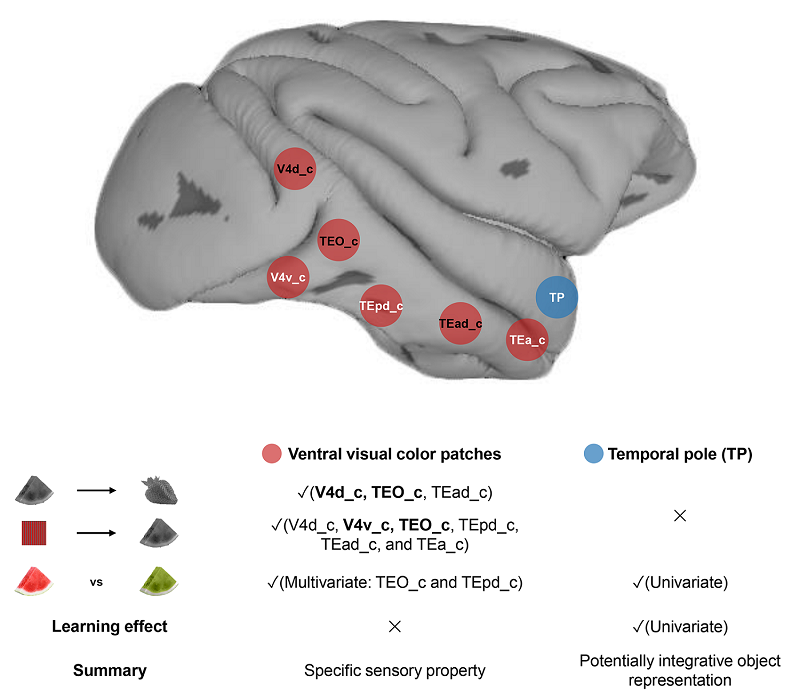How Do Macaque Brains Represent Object Color Knowledge?
Do macaque monkeys, like humans, know that watermelons are red and bananas are yellow? If so, how does their brain represent this color knowledge? As a non-human primate without a developed language system, the mechanisms by which macaque monkeys represent such knowledge remain to be explored.
A collaborative team from the Institute of Biophysics of the Chinese Academy of Sciences and Beijing Normal University conducted functional MRI (fMRI) and behavioral eye-tracking experiments in macaques. They discovered that, despite lacking language, macaques, similar to humans, store object color knowledge within areas dedicated to color perception (called color patches). These findings support the evolutionary conservatism of knowledge representation based on perceptual experience.
This study was published in PLoS Biology on November 7, 2024.
The researchers began by identifying the color patches in the monkey brain by comparing its responses to colored versus grayscale gratings (Figure 1A). Using multivoxel pattern analysis (MVPA), they demonstrated that several color patches, including V4d_c, TEO_c, and TEad_c, could distinguish grayscale objects associated with different memory colors (Figure 1B, C).
To further investigate whether the monkeys' memory of colors for these grayscale objects aligns with actual perceptual experiences, the researchers trained a classifier using three types of colored gratings and tested it on grayscale objects with corresponding memory colors. The results showed that the neural response patterns of color patches (i.e., V4d_c, V4v_c, TEO_c, TEpd_c, TEad_c, and TEa_c) could all successfully be translated between color gratings and grayscale objects with corresponding memory colors (Figure 1D, E).
Additionally, the researchers found that the color patches (e.g., TEO_c and TEpd_c) could differentiate between stimuli of true and false colors based on response patterns (Figure 1F, G).
Finally, eye-tracking experiments showed that monkeys displayed a stronger preference for looking at true-colored objects, indicating they can behaviorally distinguish true-colored stimuli from false-colored ones. This finding provided compelling behavioral evidence that monkeys possess knowledge of object colors.
In conclusion, this study reveals that macaques, like humans, also hold knowledge about object colors. This knowledge is stored in the color patches (particularly TEO_c) based on visual color experiences (Figure 2).
This study demonstrates that the perceptual experience-based knowledge representation observed in the human brain is evolutionarily conservative and not the results of language.

Figure 1. Representation of Object Color Memory in Color Patches
(Image by LIU Ning's group)

Figure 2. Schematic View of the Distributed Representation of Object Color Knowledge in the Macaque Brain
(Image by LIU Ning's group)
Article link: https://journals.plos.org/plosbiology/article?id=10.1371/journal.pbio.3002863
Contact: LIU Ning
Institute of Biophysics, Chinese Academy of Sciences
Beijing 100101, China
Email: liuning@ibp.ac.cn
(Reported by Prof. LIU Ning's group)

